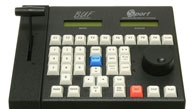Slow-motion controllers recall the big play

Slow-motion control for sports programming has gotten so simple that even talent can do it on the air. Today’s “slo-mo” devices, ranging from tiny, simple controllers to full-featured, networkable systems, all provide the same basic function — to allow sports footage to play at slower or faster than real-time speeds for play analysis.
The choice of systems and prices vary widely, depending on application and features. Most systems are designed to work with a hard disk drive or server system. All are easier to use than ever before and were on display at the 2009 NAB Show in Las Vegas this week.
BUF Technology’s Sport-HD replay system allows instant replay in multiple HD formats. A half-rack unit of gear per channel, the BUF device is not a PC but a stand-alone processor. It handles up to six HDSCI channels and is 3-D capable. It uses JPEG2000 compression and records to a removable 500G hard disk.
DNF Controls offers the ST304 slow-motion controller and the Dakota control device. The ST304 allows the user to mark in/out points on the fly, and then play back instant replays without disrupting the record process. One can quickly toggle between live and playback at the press of a button to stay on top of the action. It weighs only 4lbs and has a 12in by 6in footprint. The ST304 provides VTR-like control of Sony’s DSR-DR1000 DVCAM hard disk recorder.
The company’s new Dakota system gives on-air announcers and producers control over on-air playback, including pause, play and slow-motion forward and reverse at fixed speeds on the on-air channel. It automatically switches control of the on-air playback channel to the announcer or producer and has override control from the production control room.
The Dakota supports control of VTRs, EVS Multicam LSM and other sports playback systems, graphics systems and GPI-controlled systems. Its configurations can be quickly saved and restored and easily changed between shows.
EVS now offers its Multicam LSM system, which provides instant slow-motion playback for multiple channels of HD or SD. It’s now available in replay-only mode or with full live editing facilities. Running on EVS XT[2] servers, Multicam LSM also offers super slow-motion and delay functions for live and near-live presentation of sporting events.
The professional video industry's #1 source for news, trends and product and tech information. Sign up below.
The package integrates into any live production configuration and workflow — from acquisition through editing to playout and archiving. It features EVS loop recording technology to ensure that a critical shot is never missed. All camera sources are continuously recorded.
Operators can share media across the network without duplicating content. Each XT[2] server can handle six video channels and 48 audio tracks. The Multicam LSM has intuitive clip management functions, live access to metadata, keyword indexing and fast network access. Replay speed can be varied from 400 percent slower to 400 percent faster.
Finally, Grass Valley is relatively new to the category with the K2 Dyno replay system, a controller designed for HD production trucks and shared-storage production facilities. The unit includes a T-bar, switcher-quality buttons, a touch-screen LCD and high-speed GigE networking. It is designed to work with the company’s new K2 Summit production client.
For larger operations, the controller can operate as a dedicated client within the IT-centric MediaFrame metadata architecture. This ability allows users to gain access to all of the information about a specific clip through the K2 Dyno replay controller. With the K2 Dyno replay controller, users can import and export MXF, QuickTime and GXF (SMPTE 360M) files directly using any USB device.
